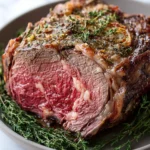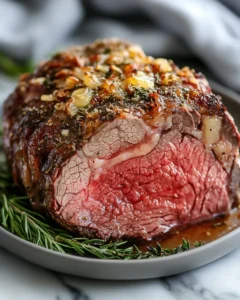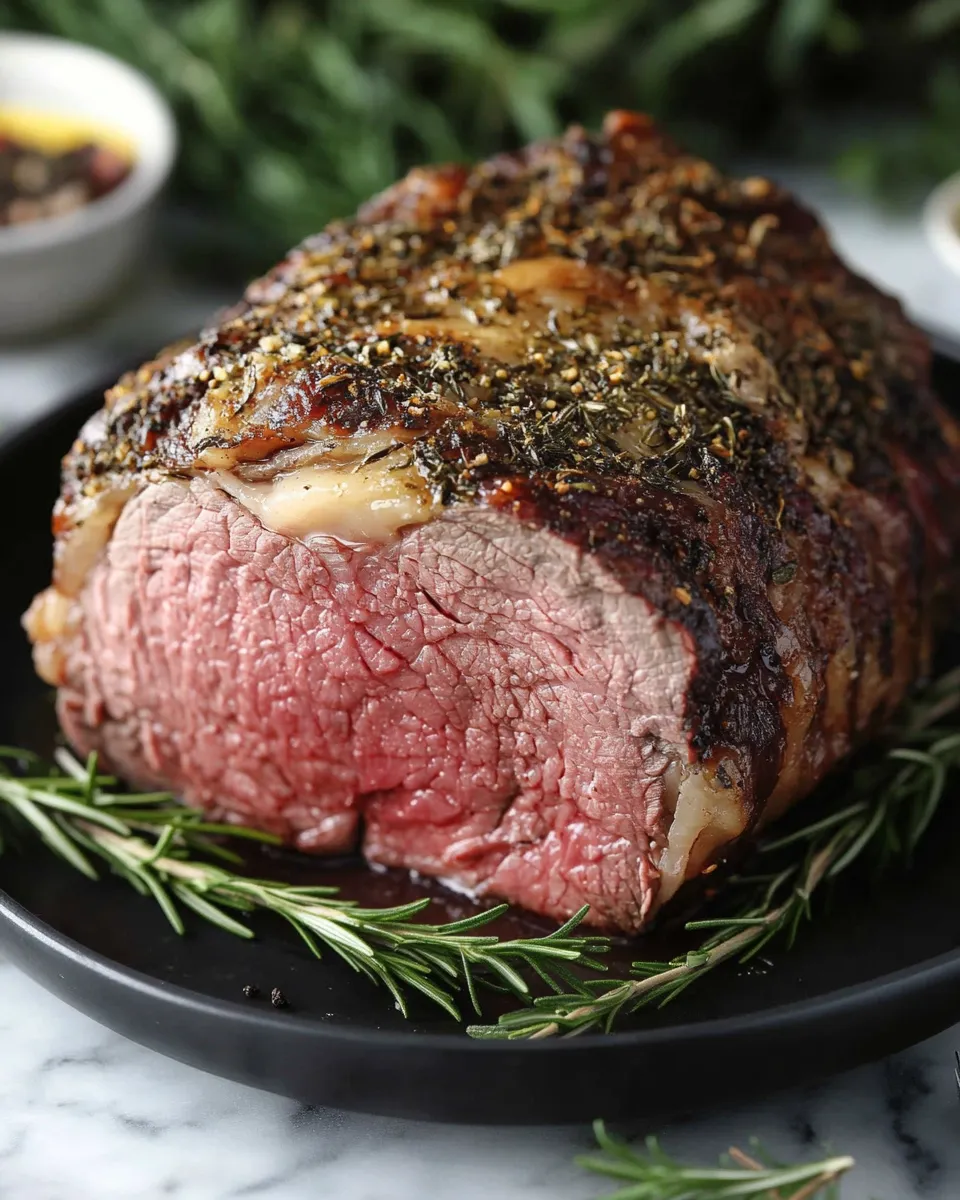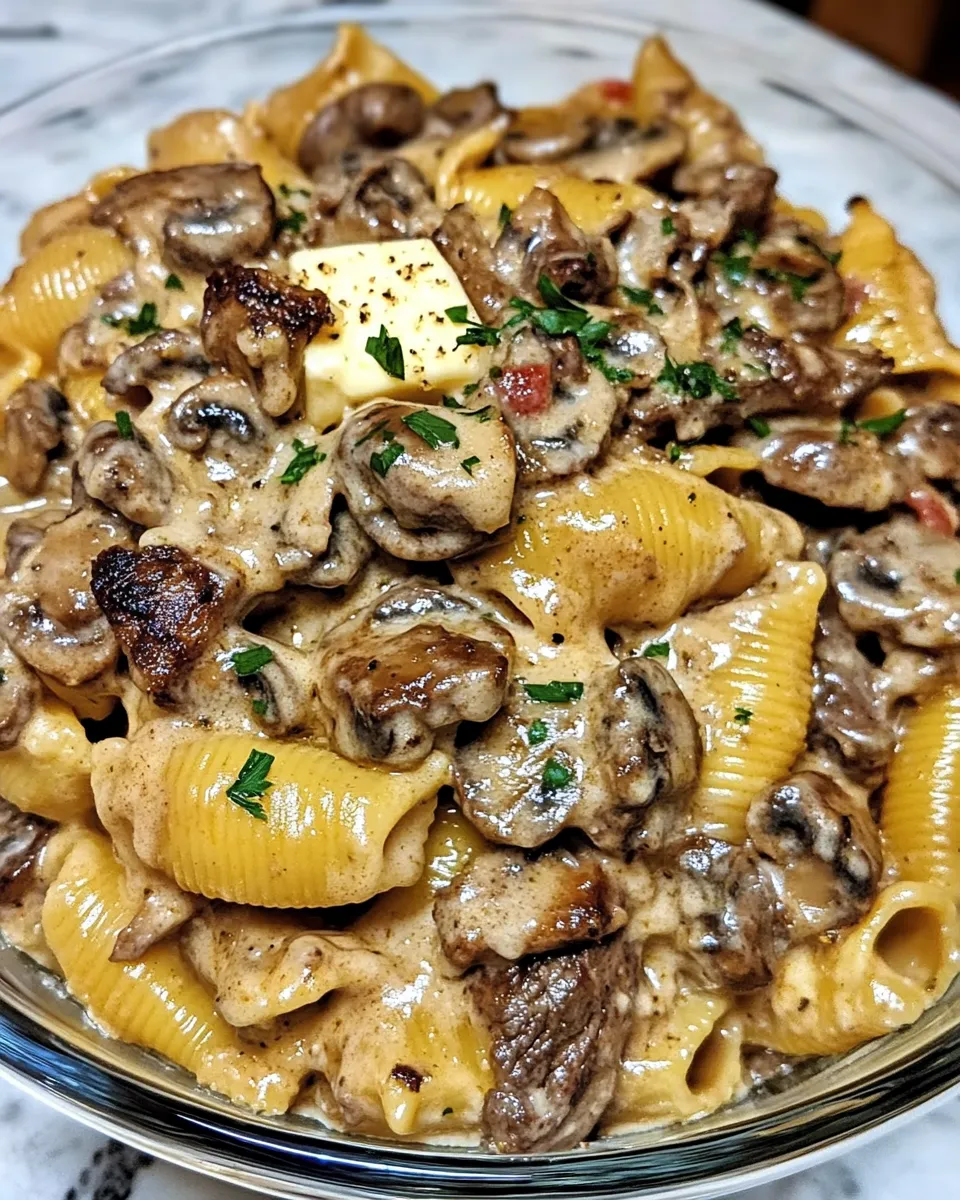Few dishes can match the elegance and indulgence of a perfectly roasted prime rib. The aroma of garlic and butter filling the kitchen creates an instant sense of celebration, making it the centerpiece for special occasions, cozy family dinners, or holiday feasts. This Garlic Butter Prime Rib Roast is designed for those who want a restaurant-quality meal at home without unnecessary complexity.
Inspired by classic culinary traditions, this recipe takes the rich, juicy flavors of prime rib and enhances them with a decadent garlic butter rub, creating a crust that locks in moisture while adding layers of savory flavor. Whether you’re celebrating a birthday, hosting a dinner party, or simply craving a comforting meal, this roast promises to impress both visually and gastronomically.
Ingredients
-
1 (5-6 lb) prime rib roast, bone-in or boneless
-
1/2 cup unsalted butter, softened
-
6 cloves garlic, minced
-
2 teaspoons sea salt
-
1 teaspoon freshly ground black pepper
-
2 teaspoons fresh rosemary, finely chopped
-
2 teaspoons fresh thyme, finely chopped
-
1 teaspoon onion powder
-
1 tablespoon olive oil
-
Optional: fresh rosemary and thyme sprigs for garnish
Directions
-
Prepare the roast: Remove the prime rib from the refrigerator at least one hour before cooking to bring it to room temperature. This step ensures even cooking and helps the roast retain its juices.
-
Preheat the oven: Set your oven to 450°F (230°C). High heat at the beginning will help create a flavorful crust.
-
Make the garlic butter: In a small bowl, combine softened butter, minced garlic, sea salt, black pepper, rosemary, thyme, and onion powder. Mix thoroughly to create a smooth, aromatic paste.
-
Apply the rub: Pat the prime rib dry with paper towels. Gently loosen the fat cap and spread a portion of the garlic butter mixture under it. Rub the remaining garlic butter evenly over the entire surface of the roast.
-
Prepare the roasting pan: Place the prime rib on a roasting rack set inside a shallow roasting pan. Drizzle olive oil over the top to promote browning. Optionally, scatter rosemary and thyme sprigs around the roast for added aroma.
-
Initial high-heat roast: Place the roast in the preheated oven for 20 minutes at 450°F (230°C). This will sear the outside and lock in the juices.
-
Reduce heat and continue roasting: Lower the oven temperature to 325°F (165°C) and continue roasting. Use a meat thermometer to monitor doneness:
-
Rare: 120-125°F (49-52°C)
-
Medium-rare: 130-135°F (54-57°C)
-
Medium: 140-145°F (60-63°C)
-
-
Rest the roast: Remove the roast from the oven and tent it loosely with aluminum foil. Allow it to rest for 20-30 minutes. Resting is essential to let the juices redistribute, ensuring a moist and flavorful slice.
-
Carve and serve: Slice the prime rib against the grain for maximum tenderness. Serve with your favorite sides, such as roasted vegetables, creamy mashed potatoes, or a fresh green salad.
Tips for the Perfect Prime Rib
-
Bring meat to room temperature: Never place a cold roast directly into the oven. Allowing it to sit for an hour before cooking ensures even heat penetration.
-
Use a meat thermometer: Oven times vary, so using a thermometer is the most reliable way to achieve your preferred doneness.
-
Let it rest: Resting is not optional; it guarantees a juicy interior and prevents dry edges.
-
Customize the herb mix: Feel free to experiment with sage, oregano, or parsley in the garlic butter mixture for a personalized flavor profile.
Suggested Side Dishes
A prime rib roast deserves sides that complement its rich, savory flavor without overpowering it. Consider pairing it with:
-
Garlic mashed potatoes: Creamy and buttery, a classic side that mirrors the roast’s flavors.
-
Roasted root vegetables: Carrots, parsnips, and potatoes tossed in olive oil and herbs roast perfectly alongside the meat.
-
Green bean almondine: Lightly sautéed green beans with toasted almonds add texture and freshness.
-
Caesar salad: Crisp romaine, creamy dressing, and Parmesan bring a bright contrast to the heavy roast.
-
Yorkshire pudding: Traditional and indulgent, perfect for soaking up the roast juices.
Make-Ahead Tips
If you’re preparing this prime rib for a holiday or special occasion, consider these make-ahead strategies:
-
Season in advance: Apply the garlic butter rub up to 24 hours ahead of time and refrigerate the roast. This allows the flavors to penetrate deeply into the meat.
-
Prep side dishes: Many sides, such as mashed potatoes and roasted vegetables, can be partially cooked ahead of time to minimize stress on the day of serving.
-
Rest overnight: Some chefs recommend dry-aging in your refrigerator for an extra day to enhance tenderness and flavor, though this step is optional.
Why This Garlic Butter Prime Rib Roast Stands Out
Prime rib is naturally luxurious, but the addition of garlic butter elevates it to a memorable, restaurant-quality experience. The combination of fresh herbs, aromatic garlic, and rich butter creates a crust that is both flavorful and visually appealing. Every slice offers a perfect balance of crusty exterior and tender, juicy interior, making it an ideal centerpiece for any gathering.
What makes this recipe truly special is its accessibility. While prime rib may seem intimidating to some home cooks, this step-by-step guide simplifies the process without compromising flavor. Even if it’s your first time roasting, following these instructions guarantees success and the admiration of your guests.
Variations to Try
-
Herb-Crusted Prime Rib: Increase the amount of rosemary and thyme, and add sage or tarragon for a more herbal-forward profile.
-
Garlic and Mustard Crust: Mix Dijon mustard into the garlic butter for a subtle tang that pairs beautifully with the meat.
-
Spiced Prime Rib: Add paprika, cayenne, or crushed black pepper to the garlic butter for a slight kick.
-
Lemon-Infused Butter: Incorporate lemon zest into the garlic butter for a bright, fresh finish.
Frequently Asked Questions
1. Can I use a boneless prime rib?
Yes, boneless prime rib works very well for this recipe and can be slightly easier to carve, especially for home cooks who prefer not to deal with the bone. Boneless roasts typically cook a little faster than bone-in roasts, so it’s important to monitor the internal temperature closely to avoid overcooking. The bone, when present, helps the meat retain moisture and adds flavor during roasting, but a boneless cut will still be juicy and flavorful if prepared correctly. For best results, follow the same garlic butter rub and roasting instructions, and adjust the cooking time slightly based on weight. A meat thermometer is key here to ensure you achieve your preferred level of doneness without guessing.
2. How do I know when the roast is done?
The most reliable way to determine doneness is to use a meat thermometer. Insert it into the thickest part of the roast, making sure it doesn’t touch bone or fat, which can give inaccurate readings. For rare, the internal temperature should reach 120–125°F; for medium-rare, aim for 130–135°F; and for medium, 140–145°F. Keep in mind that the roast will continue to cook slightly as it rests outside the oven, so it’s better to remove it a few degrees below your target temperature. Checking early and often is better than guessing. Additionally, look for visual cues such as a well-browned crust and juices that run slightly pink when pierced.
3. Can I prepare this recipe without fresh herbs?
Absolutely! While fresh herbs like rosemary and thyme provide a bright, aromatic flavor, dried herbs are a convenient and effective alternative. If using dried herbs, use about one-third of the quantity recommended for fresh herbs, since dried herbs have a more concentrated flavor. For example, 2 teaspoons of fresh rosemary would be replaced with roughly 2/3 teaspoon of dried rosemary. The garlic butter mixture will still impart incredible flavor and aroma, ensuring your prime rib is delicious even without fresh ingredients. Combining dried herbs with a pinch of high-quality salt and freshly cracked black pepper can make a remarkable difference.
4. How long does leftover prime rib stay fresh?
Proper storage is key to maintaining flavor and safety. Leftover prime rib should be stored in an airtight container in the refrigerator for up to 4 days. Slices should be kept separated by wax paper or foil to prevent sticking and preserve texture. If you want to extend storage, you can freeze slices for up to 3 months. When reheating, do so gently—either in a low oven or wrapped in foil with a splash of beef broth—to avoid drying out the meat. Reheating slowly helps preserve the tenderness and ensures your leftovers are almost as good as freshly roasted.
Final Thoughts
The Garlic Butter Prime Rib Roast is more than a meal; it’s an experience. The rich aroma, the tender texture, and the deep, savory flavor combine to make every bite memorable. This recipe transforms ordinary gatherings into festive celebrations, creating moments your family and friends will remember long after the last slice is gone.
Whether it’s for a holiday feast, a milestone celebration, or a simple weekend indulgence, this roast embodies comfort, luxury, and timeless culinary tradition. With just a few simple ingredients and careful attention to roasting times, anyone can achieve a prime rib worthy of admiration and repeated enjoyment.
Roasting a prime rib may seem like a culinary challenge, but with this recipe, it becomes a joyful and rewarding endeavor. From the first rub of garlic butter to the final resting period before slicing, every step is an opportunity to savor anticipation. When the golden crust is finally revealed and the juicy slices are served, the effort pays off in a meal that’s both stunning and delicious.
Serve, savor, and celebrate every bite of this unforgettable Garlic Butter Prime Rib Roast.
Print
Irresistible Garlic Butter Prime Rib Roast Recipe
- Total Time: 2 hours 50 minutes
- Yield: 8–10 servings 1x
Description
This Garlic Butter Prime Rib Roast is the ultimate centerpiece for special occasions, family gatherings, or holiday dinners. Infused with a rich garlic butter and fresh herbs, this roast delivers a juicy, flavorful interior with a perfectly crusted exterior. With simple steps and a few key ingredients, you can bring restaurant-quality prime rib to your own dining table and impress your guests effortlessly.
Ingredients
-
1 (5-6 lb) prime rib roast, bone-in or boneless
-
1/2 cup unsalted butter, softened
-
6 cloves garlic, minced
-
2 teaspoons sea salt
-
1 teaspoon freshly ground black pepper
-
2 teaspoons fresh rosemary, finely chopped
-
2 teaspoons fresh thyme, finely chopped
-
1 teaspoon onion powder
-
1 tablespoon olive oil
-
Optional: fresh rosemary and thyme sprigs for garnish
Instructions
-
-
Remove the prime rib from the refrigerator at least one hour before cooking to bring it to room temperature.
-
Preheat oven to 450°F (230°C).
-
In a small bowl, combine softened butter, minced garlic, sea salt, black pepper, rosemary, thyme, and onion powder to create a smooth garlic butter mixture.
-
Pat the prime rib dry with paper towels. Loosen the fat cap and spread some garlic butter under it, then rub the remaining butter mixture over the surface.
-
Place the roast on a roasting rack in a shallow roasting pan. Drizzle with olive oil and scatter herb sprigs around if desired.
-
Roast in the oven at 450°F for 20 minutes to sear the exterior.
-
Reduce oven temperature to 325°F (165°C) and continue roasting until the meat reaches desired doneness:
-
Rare: 120–125°F (49–52°C)
-
Medium-rare: 130–135°F (54–57°C)
-
Medium: 140–145°F (60–63°C)
-
-
Remove roast from oven and tent loosely with foil. Rest for 20–30 minutes to allow juices to redistribute.
-
Slice against the grain and serve with your favorite sides.
-
Notes
Bring meat to room temperature for even cooking. Use a meat thermometer for accurate doneness. Garnish with fresh herbs for presentation. Resting the roast is essential for a juicy interior.
- Prep Time: 20 minutes
- Cook Time: 2 hours 30 minutes








